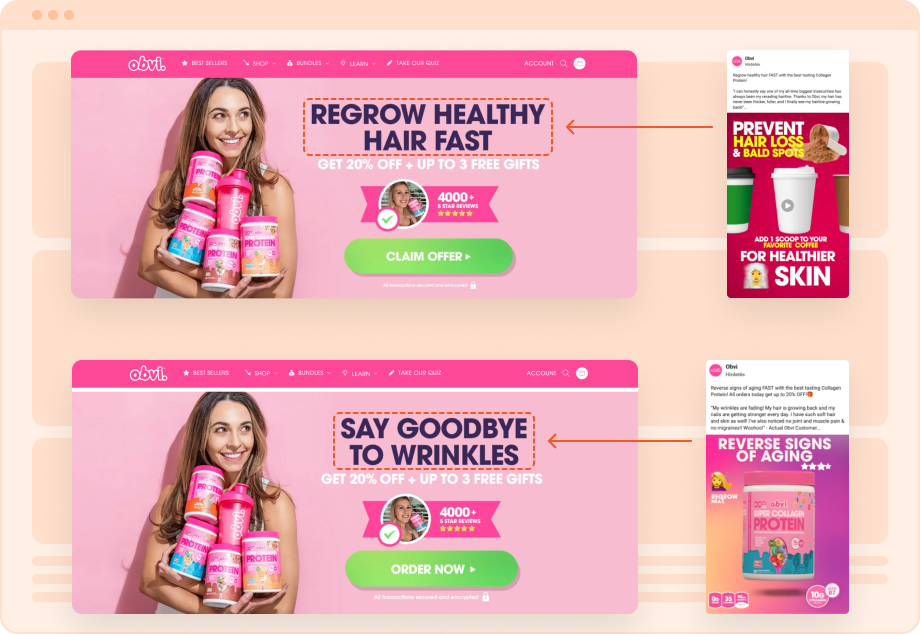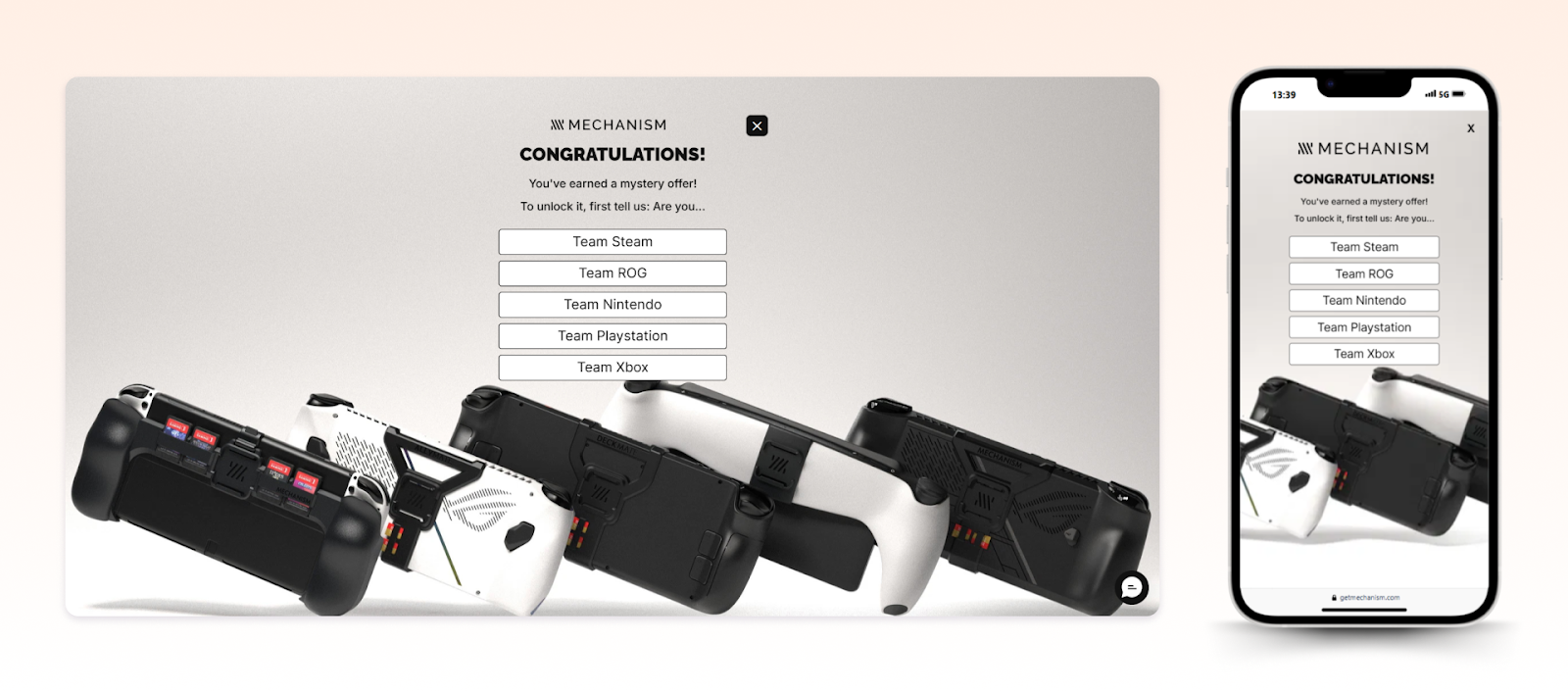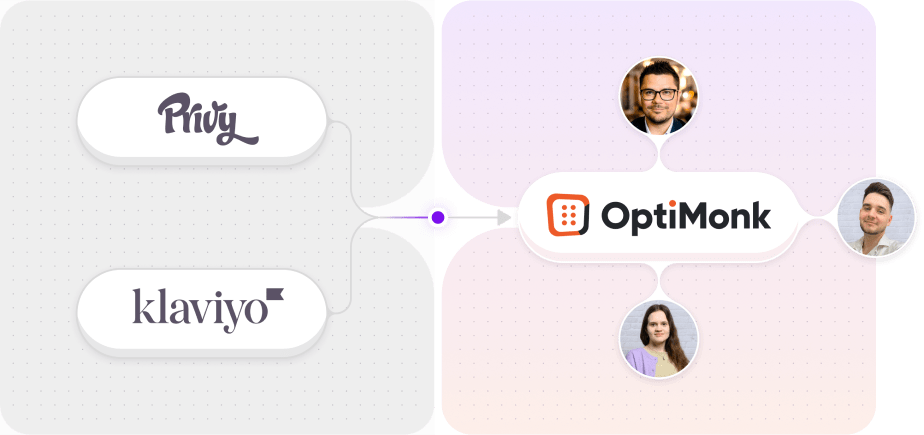- Blog
- Personalization FAQ: Everything You Need to Know About Personalization
Personalization FAQ: Everything You Need to Know About Personalization
Table of Contents
What is personalization?
Personalization refers to the practice of tailoring content, experiences, and communications to individual users based on their behaviors, preferences, or demographic data.
In marketing, it means using this information to make the customer feel as if the experience was created specifically for them.
What are synonyms for personalization?
Synonyms for personalization include:
- Customization
- Tailoring
- Individualization
What does personalization mean in marketing?
In marketing, personalization means using customer data to deliver more relevant messages, offers, and experiences. It could include things like tailored emails, product recommendations, or personalized website content based on user behavior or demographics.
What is personalization on a website?
Website personalization involves showing each visitor content that’s relevant to them based on their behavior.
Examples: personalized product recommendations, dynamic headlines, location-based offers, or reminders about previously viewed items.
What is the meaning of personalizer?
A “personalizer” is typically a tool, feature, or software that enables personalization.
It could be an algorithm, CRM system, or an engine that adjusts website content, offers, or messages based on individual user data.
How important is personalization?
Extremely important. Personalization increases conversions, reduces bounce rates, boosts average order value, and creates a smoother, more human experience. Customers expect that generic websites feel outdated and lose sales to competitors offering tailored journeys.
What is the psychology behind personalization?
Personalization works because it triggers three psychological principles:
- Relevance: People pay more attention when something feels meant for them.
- Familiarity: Personalized experiences reduce uncertainty and build trust.
- Cognitive ease: Tailored recommendations remove decision fatigue, making it easier to buy.
Which one is correct, personalised or personalized?
Both are correct—personalised is British English, and personalized is American English.
Use the version that fits your brand or audience.
What are the challenges of website personalization?
The biggest challenges include:
- Data collection limitations (privacy rules, cookie restrictions)
- Fragmented tech stacks that don’t integrate well
- Low data quality leading to inaccurate personalization
- Over-personalization, which can feel creepy
- Scaling personalization without slowing down the website
What are the 5 key features of personalization?
The five key features of personalization are:
- Data collection: Gathering information about customers’ preferences, behaviors, and demographics.
- Segmentation: Dividing customers into meaningful groups based on shared characteristics.
- Tailored content: Creating content that aligns with the interests of specific customer segments.
- Real-time personalization: Offering experiences or recommendations based on current user behavior.
- Cross-channel personalization: Delivering a consistent personalized experience across various touchpoints (web, email, mobile, etc.).
What is a personalization strategy?
A personalization strategy is a comprehensive plan that outlines how to use customer data to create tailored experiences at different stages of the customer journey.
It involves deciding which data to collect, how to segment customers, and how to apply personalized content across marketing channels.
Which is an example of personalization?
An example of personalization is when an ecommerce site tailors the experience to each visitor, like displaying product recommendations based on browsing behavior or past purchases.
For example, Lammle’s uses an exit-intent popup that suggests products aligned with the visitor’s browsing history, making the offer more relevant and compelling.

Another example is Obvi, which provides tailored landing page content that aligns with their ads, ensuring the visitor experiences a cohesive journey.

How does Amazon do website personalization?
Amazon uses a mix of behavioral tracking, purchase history, browsing data, and machine-learning models to personalize nearly everything:
- Product recommendations (“Customers who bought this also bought…”)
- Homepage tailored to shopping habits
- Dynamic search results
- Cross-sell and upsell placements
- Recently viewed item reminders
- Their entire site adjusts in real time based on your interactions.
How to build an effective personalization strategy?
To develop an effective personalization strategy, start by defining clear objectives, such as increasing conversions or improving customer engagement.
Next, gather and analyze various types of data, including zero-party, first-party, and third-party data, to gain valuable insights into customer preferences.
Segment your audience based on their behaviors and interests to ensure targeted messaging.
Choose the most appropriate channels to deliver personalized experiences, whether that’s through email, website, or mobile apps.
Finally, regularly test and optimize your personalization efforts to fine-tune your approach and ensure it continues to drive results.
What are the core goals for a successful personalization initiative?
The core goals of personalization are:
- Improved customer experience: Tailoring interactions to be relevant and valuable, improving satisfaction and engagement.
- Increased conversion rates: Delivering compelling offers and targeted content that encourage customers to act.
- Higher customer loyalty: Building trust through personalized communication, leading to repeat business.
- Increased average order value (AOV): Offering smarter product recommendations that drive customers to purchase more.
How can businesses tailor the customer experience using data?
Businesses can tailor experiences by leveraging:
- Demographic data (e.g., age, location, gender) to deliver targeted ads and offers that align with specific customer profiles and life stages.
- Attitudinal data (e.g., preferences, values) to create personalized messaging and offers that resonate with customers’ beliefs and interests.
- Behavioral data (e.g., past purchases, browsing history) to recommend relevant products based on customer actions and interests.
What teams should be involved in planning and executing a personalization strategy?
Key teams involved in planning and executing a personalization strategy include:
- marketing (for content and campaigns),
- data/analytics (for customer segmentation),
- product (for adjusting offerings),
- UX/UI design (for personalized experiences),
- and tech/development (for implementing the necessary infrastructure).
What is the best way to offer a personalized experience to my clients?
The best way to offer a personalized experience to your clients is by first gathering data through surveys, cookies, and behavioral analytics. This allows you to understand your clients’ preferences, interests, and behaviors.
You can then use this data to deliver personalized recommendations, send tailored email campaigns that resonate with individual needs, and present dynamic content on your website that adapts to each visitor’s actions.
By consistently collecting and analyzing data, you can create a seamless and relevant experience that engages customers and encourages conversions.
How do you strike a balance between personalization and efficiency/scalability in outbound campaigns?
To balance personalization with scalability, you can use automated personalization tools, like email automation, that segment users at scale.
Implement personalization rules, such as dynamic content blocks in emails, that apply to broad customer segments while still feeling tailored.
Additionally, prioritize high-impact segments for deep personalization, while applying lighter approaches for the broader audience.
How will we measure success for personalization efforts?
Key KPIs include:
- Conversion rates (click-through, purchase rates).
- Engagement metrics (email open rates, time spent on site).
- Customer satisfaction (e.g., NPS, customer feedback).
- Return on investment (ROI) from personalized campaigns.
- Customer retention and repeat purchase rates.
How can you quantify the impact of personalized customer experiences?
Quantifying impact can be done by comparing conversion rates and AOV (average order value) between personalized and non-personalized segments, tracking customer lifetime value (CLV) growth for personalized customer journeys, and measuring customer satisfaction and engagement metrics.
What are the essential technologies needed for personalization?
Key technologies include:
- CRM systems (e.g., Salesforce) to manage and store customer data.
- Analytics tools (e.g., Google Analytics, Hotjar) for tracking user behavior.
- Personalization engines (e.g., OptiMonk, Dynamic Yield) for tailoring website content or emails.
What are the best website personalization tools?
Some of the strongest tools available today include:
- OptiMonk: Onsite personalization, dynamic content, product recommendations, quizzes.
- Dynamic Yield: Enterprise-level personalization with strong ML.
- Bloomreach: AI-driven commerce personalization.
- Segment + Mixpanel: Customer data + behavioral insights combo.
- Optimizely: Testing and personalization suite.
Each tool serves different needs. OptiMonk is best for ecommerce brands wanting fast, no-code personalization across popups, landing pages, product pages, and dynamic content.
What type of customer data can/should a personalization tool capture?
Personalization tools typically capture:
- Zero-party data: Information customers explicitly share, like preferences and interests.
- First-party data: Information collected from direct customer interactions (website behavior, purchase history).
- Second-party data: Data shared from trusted partners.
- Third-party data: Data collected from external sources like advertising networks.
Which type of customer segments does a personalization tool allow you to create?
Personalization tools enable you to create customer segments based on various data types, ensuring targeted, relevant experiences.
These include:
- Geographic data, enables you to offer location-based recommendations or promotions, tailoring content to regional preferences or seasonal trends.
- Demographic data, like age, gender, income, and occupation, which helps you personalize offers and content according to general characteristics or life stage.
- Behavioral data, such as past purchases, browsing history, and interactions on your website, allows you to tailor recommendations and content based on how customers engage with your brand.
- Psychographic data, which includes customers’ interests, values, and lifestyle choices, helps you craft messages and offers that resonate with their deeper motivations and preferences.
What are the privacy and ethical concerns of collecting and using customer data for personalization?
Concerns include:
- Data privacy laws (e.g., GDPR, CCPA) require explicit consent and transparency in data collection.
- Ethical use of data, ensuring it is used responsibly and not for intrusive targeting.
- Data security to protect customer information from breaches.
What is the difference between personalization vs. customization?
Personalization is driven by the brand, using customer data to tailor experiences. Customization allows the customer to control aspects of their experience (e.g., customizing product options or profile settings).
How do you avoid "over-personalization" that may feel intrusive or "creepy" to customers?
To avoid over-personalization that might feel intrusive or “creepy” to customers, limit the use of personal data, avoiding excessive detail sharing.
It’s also important to offer clear opt-in and opt-out options for customers and keep personalization subtle to ensure they don’t feel overly tracked.
Is algorithm-based personalization always worth the effort, or is "bad personalization" worse than no personalization?
Bad personalization can be worse than no personalization because it can lead to irrelevant or annoying experiences.
It’s important to ensure algorithms are well-tested and that personalization is based on reliable, high-quality data.
What is the role of personalization in ecommerce marketing (beyond just product recommendations)?
In ecommerce marketing, personalization extends beyond product recommendations.
It involves dynamic content on landing pages, personalized email campaigns with relevant product suggestions, and customized pricing or promotions based on individual buying habits.
With OptiMonk, you can personalize your landing page headlines and test different unique selling propositions (USPs).
The platform allows you to easily experiment with various value propositions using Dynamic Content.
What are the best channels for personalization?
The best channels for personalization include the website, where you can offer personalized homepages, landing pages, product recommendations, and banners.
Email is another effective channel, allowing for tailored offers and product recommendations.
Mobile apps provide opportunities for personalized push notifications and in-app messages. Lastly, live chat can be personalized by using customer history to offer more relevant support.
You can also personalize product recommendations through popups, using targeted product recommendation popups:
What are the emerging personalization trends?
Emerging trends include the digitization of physical spaces, such as AR/VR experiences in stores.
Another trend is scaling empathy by creating more human-like, responsive AI interactions.
Additionally, real-time personalization is becoming more prevalent, with AI dynamically adjusting content as customers navigate through websites.
What is a personalization quiz, and how does it help ecommerce businesses?
A personalization quiz is an interactive tool that collects information from users (e.g., preferences, needs) and then delivers tailored product recommendations.
It helps ecommerce businesses by improving product discovery and engagement, leading to higher conversions.
Here’s an example from Mechanism, and how they implemented a quiz on their website:

Is targeted advertising the same as personalized advertising?
No, targeted advertising focuses on delivering ads based on specific customer segments or behaviors, while personalized advertising tailors the content of the ad itself to the individual, often using personal data to craft the message.
How can personalization be applied differently in B2B versus B2C marketing?
In B2B, personalization is more focused on account-based marketing, with tailored solutions for each business’s needs.
In B2C, personalization is typically more consumer-focused, addressing individual preferences or behaviors with product recommendations and offers.
How do customer personas improve personalization?
Customer personas help by giving brands a deeper understanding of their target audience’s needs, goals, and pain points.
This allows businesses to create more targeted, relevant experiences that resonate with different customer types.
How can personalization be scaled for larger audiences?
Personalization can be scaled using automation, AI-powered tools, and dynamic content that adapts based on customer data.
By automating certain aspects of personalization (e.g., email or website content), businesses can maintain relevance at scale.
How does personalization work differently for anonymous vs known users?
For anonymous users, personalization is limited to basic data like cookies or browsing behavior. For known users, it’s more refined, based on their past interactions, purchase history, and explicit preferences.
Does personalization always lead to higher conversion/loyalty, or are there cases where it backfires?
Personalization can increase conversion and loyalty, but if overdone or misaligned, it can feel intrusive and lead to decreased trust or alienation.
It’s important to ensure that the personalization is genuinely useful to the user.
What are the emerging trends in personalization for 2026?
Trends include increased AI-driven real-time personalization across channels, with voice search and AI assistants playing a bigger role.
Hyper-personalization is also on the rise, utilizing data from IoT devices.
Additionally, we’re seeing more immersive experiences, such as AR/VR, being incorporated into personalization efforts.
Which touch‑points should we personalize first and why?
Start with email and website, as these are the most direct and measurable channels.
Email can be used for quick wins with personalized offers, while websites can use behavioral data for recommendations and tailored content.
Migration has never been easier
We made switching a no-brainer with our free, white-glove onboarding service so you can get started in the blink of an eye.

What should you do next?
Thanks for reading till the end. Here are 4 ways we can help you grow your business:
Boost conversions with proven use cases
Explore our Use Case Library, filled with actionable personalization examples and step-by-step guides to unlock your website's full potential. Check out Use Case Library
Create a free OptiMonk account
Create a free OptiMonk account and easily get started with popups and conversion rate optimization. Get OptiMonk free
Get advice from a CRO expert
Schedule a personalized discovery call with one of our experts to explore how OptiMonk can help you grow your business. Book a demo
Join our weekly newsletter
Real CRO insights & marketing tips. No fluff. Straight to your inbox. Subscribe now
Barbara Bartucz
- Posted in
- Personalization
Partner with us
- © OptiMonk. All rights reserved!
- Terms of Use
- Privacy Policy
- Cookie Policy













